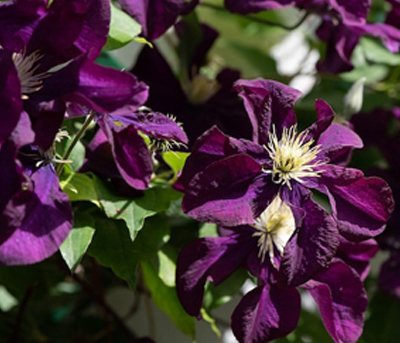
Climbing stars – let late summer clematis take a leading role
They must be one of the most impressive climbing plants, with glorious blooms in a beautiful range of shades, but there’s no denying clematis can be tricky. Winter and spring types can mostly take care of themselves, but summer flowering clematis fall into several different categories, all needing pruning, and if you prune at the wrong time of year, you could lose a year’s flowers. It’s this kind of calendar-watching that puts lots of people off gardening, so my rule of thumb is always to keep it simple and choose things that don’t need to be mollycoddled.
Which is why the only summer clematis in my garden is a viticella, Etoile Violette. Etoile is French for star, and this five petalled, star shaped beauty is the deepest, duskiest shade of violet you can imagine. As a viticella type clematis, it is deciduous, but as it flowers on the current season’s growth – like roses – you can chop it down almost to the ground in winter and then forget about it till next year. Ideally you’d cut each stem back to a pair of buds six to eight inches above the ground, but I don’t even bother with this, I just hack it down to a foot or so and it obligingly re-grows each year.
If growing on a trellis or obelisk, you could tie in the new shoots as it grows in spring, but it’s quite good at scrambling away by itself, and in my garden hoists itself obligingly up a nearby honeysuckle so that its velvety blooms can peep out all over the fence in late summer. The deep purple is a lovely foil for lighter purples, mauves and pinks, as well as anything with grey or silver foliage, and it’s quite happy cut and plonked in a jug too. Definitely one of the late summer stars!
ANNE’S TIP OF THE WEEK:
To protect against clematis wilt, a fungal disease that causes sudden collapse, plant new specimens extra deep, so that if the wilt strikes there’s a good chance of new growth from the underground shoots the following year.



